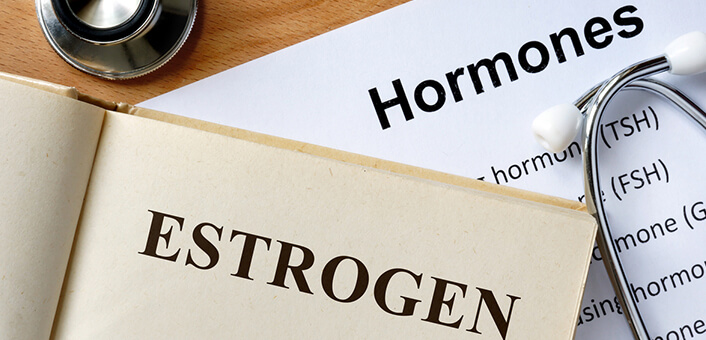
estrogen dominance article by Coach Lloyd
Suffering from symptoms like water retention, cellulite, weight gain, fatigue and breast tenderness? If the answer is yes, then you might be suffering from “Estrogen Dominance”.
What is Estrogen?
Estrogen is a sex hormone produced by both men and women which stimulates the development of secondary sexual characteristics. There are different types of estrogens however for the sake of simplicity we call them collectively Estrogen.
Estrogen is the most dominant sex hormone in women and is indeed the hormone that makes women. When men produce or somehow accumulate excessive quantities of Estrogen they will start to inhibit various female characteristics such as the development of breast tissue (man-boobs), lower levels of muscle density, and even feminine curves!
Although Estrogen is the dominant female hormone, excess Estrogen, we commonly refer to as “Estrogen Dominance” can have very negative effects on women. These include:
- water retention
- heavy or irregular periods
- breast tenderness
- mood swings
- low thyroid symptoms
- nervousness and anxiety
- facial flushing
- cellulite
- loss of energy (fatigue)
- decreased libido (sex drive)
- headaches
- weight gain (particularly around the back of the upper arm, the chest, hips, thighs and bottom)
- muscle loss
- skin conditions such as oily skin and blemishes
So, how does Estrogen Dominance develop?
Estrogen Dominance develops when there is not enough Progesterone (the foundational hormone in all vertebrates) in comparison to Estrogen. Both Estrogen and Progesterone are vital to the health of every woman. These two hormones exist in a delicate balance, and when that delicate balance is thrown off, various health complications such as those listed can develop.
Factors contributing to Estrogen Dominance
1. Xenoestrogens: One of the biggest contributors to Estrogen Dominance is Xenoestrogens (xeno literally means foreign), which are man-made chemicals that mimic Estrogen. These chemicals are polluting our food and water supplies and flooding our bodies every day with Estrogen-like substances. These chemicals include pesticides, fertilizers, herbicides, fungicides, exhaust fumes, and hormones fed to non-organic livestock.
2. Phytoestrogens: Phytoestrogens refer to plant compounds with oestrogen-like activity found in foods. These foods include soy foods, artificial sweeteners, whole-wheat products including whole-wheat bread and pasta.
Dairy Products are full of Estrogen
According to the Harvard School of Public Health, dairy milk is a leading source of estrogen. In fact, it may account for up to 80% of estrogens consumed. One reason is because most cows are dosed with growth hormones and are ripe with Xenoestrogens. Another possible reason is that cows are often milked when they are pregnant when estrogen levels are at their highest. A better option is to choose non-dairy milk such as rice or almond milk.
Other Foods to Avoid to Balance Your Hormones
You should not drink alcohol if you are estrogen dominant. Estrogen must be metabolized in the liver and drinking alcohol can cause the liver to become overworked, allowing estrogen levels to build up in your body.
Other foods to avoid include sugar, processed, and fast foods. These foods have been linked to magnesium deficiencies, which in turn have been connected to high estrogen levels.
Chocolate, tea, coffee, and other sources of caffeine and foods high in fats also contribute to estrogen dominance. Too much-unfermented soy in your diet can lead to high levels of estrogen as well.
Balance Your Hormones with Nutrition
Dietary Solutions to Estrogen Dominance
Limit saturated and hydrogenated fats:
Both saturated and hydrogenated fats compete for uptake against so-called “good fats” called Essential Fatty Acids (EFAs). This can be a major factor in determining the Estrogen/Progesterone balance. A diet low in saturated and hydrogenated fats and high in EFAs will help reduce Estrogen Dominance.
Increase fibre intake:
A diet high in fibre helps in eliminating excess Estrogen. Dietary fibre helps in reducing excess Estrogen in the blood by influencing an enzyme called “beta-glucouronidase” produced by bacteria in the gut. Good examples of high fibre foods that help are wheat bran, psyllium husks, pectins (skins and rinds of fruit and vegetables) and lignans such as linseeds, also known as flaxseed.
Eat more cultured milk products and yoghurt:
The bacteria in yoghurt, Lactobacillus acidophilus, reduces an enzyme called beta-glucouronidase which has a positive effect on oestrogen excretion. Fermented soy products such as tempeh, miso and tamari can also have the same effect.
Eat from the cabbage family:
Natural chemicals found in the cabbage family such as broccoli, cabbage, cauliflower and brussel sprouts can increase the rate at which the liver changes oestrogen into water-soluble form for excretion. Indoles such as Di-indole methane (DIM) also competitively inhibit oestrogen, and seem to inhibit the growth of breast cancer cells.
Increase your protein intake:
Adequate protein intake is necessary to metabolise oestrogen in the liver. Since many conditions are associated with excess protein intake, it is recommended that protein be taken in the form of grains, legumes, lean meat, fish, organic chicken and eggs, and that it constitutes not more than 60g of pure protein daily.
Ditch the caffeine, nicotine and alcohol:
Ditch the caffeine, nicotine and alcohol amongst other foods. Go for foods rich in sulphur such as garlic, onion, leek and cabbage which aid liver detoxification. Also consume foods high in methionine assist with the methylation of oestrogen, the chemical reaction the liver uses to break down estrogen (oestradiol) into a less potent form (estriol). Beans, legumes, onions and garlic are high in methionine.



